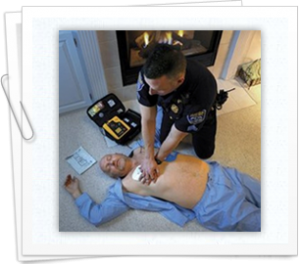Online CPR Certification Blog
Quick action is crucial for survival in sudden cardiac arrest
Date: May 26th, 2014
 Even though sudden cardiac arrest is one of the most serious epidemic proportions in the world, most sudden cardiac deaths can be prevented with prompt CPR initiation and a quick automated external defibrillator. The heart tends to beat abnormally during a cardiac arrest and it is unable to pump blood to vital body tissues, including the brain. Inadequate flow of blood and improper functioning of the heart can lead to the death of the patient within 8 minutes. About 450,000 Americans are affected each year by cardiac heart arrest, which results in death. Most of these arrests tend to occur outside hospital settings and ventricular fibrillation is a life threatening, dangerous heart rhythm that causes the attack.
Even though sudden cardiac arrest is one of the most serious epidemic proportions in the world, most sudden cardiac deaths can be prevented with prompt CPR initiation and a quick automated external defibrillator. The heart tends to beat abnormally during a cardiac arrest and it is unable to pump blood to vital body tissues, including the brain. Inadequate flow of blood and improper functioning of the heart can lead to the death of the patient within 8 minutes. About 450,000 Americans are affected each year by cardiac heart arrest, which results in death. Most of these arrests tend to occur outside hospital settings and ventricular fibrillation is a life threatening, dangerous heart rhythm that causes the attack.
Shock the heart, otherwise known as defibrillation is the best treatment available for ventricular fibrillation and it aims at resetting the heart rhythm. Cardiac arrest survival rate is associated directly with prompt CPR and defibrillation performed with an AED. Anyone who has basic CPR training is also trained on how to use an AED. But the biggest hindrance to saving lives in times of cardiac arrest is to find people who are trained properly in CPR and also access to these AEDs.
Poor preparation puts lives at a risk
According to a survey published recently by the British Medical Journal, the researchers examined the rates of cardiac arrest happening out of hospital in the UK. To get an idea of how aware and prepared the public is regarding this very serious health problem, the researchers surveyed citizens. They estimated that among the 60000 cases of cardiac arrest that happen in UK every year, only between 2 and 12 percent of the patient survive. It was also surprising to note that only between 1 and 13 percent of the participants participated agreed to using AEDs and performing CPR. The researchers concluded that it was important to increase the number of AEDs in UK and to educate the members of the public. These two would be very essential in improving survival rates in cardiac arrests and saving lives.
What needs to be done to prevent sudden cardiac arrests death?
One fact that is undeniable is that AEDs helps in saving lives. Clinical data greatly support the idea of deploying AEDs in various public spaces like sporting events, schools, airports, concert venues, churches and airports among other places that people gather in large numbers. In addition, people need to work with American Heart Association very closely as well as Heart Rhythm Society. This will help in educating others and improving awareness as to why learning CPR is very important. In fact, CPR needs to be incorporated in high school curriculum whereby students will be required to complete CPR training satisfactorily for them to graduate. There is also need to push for more systematic deployment and widespread deployment of AEDs.
